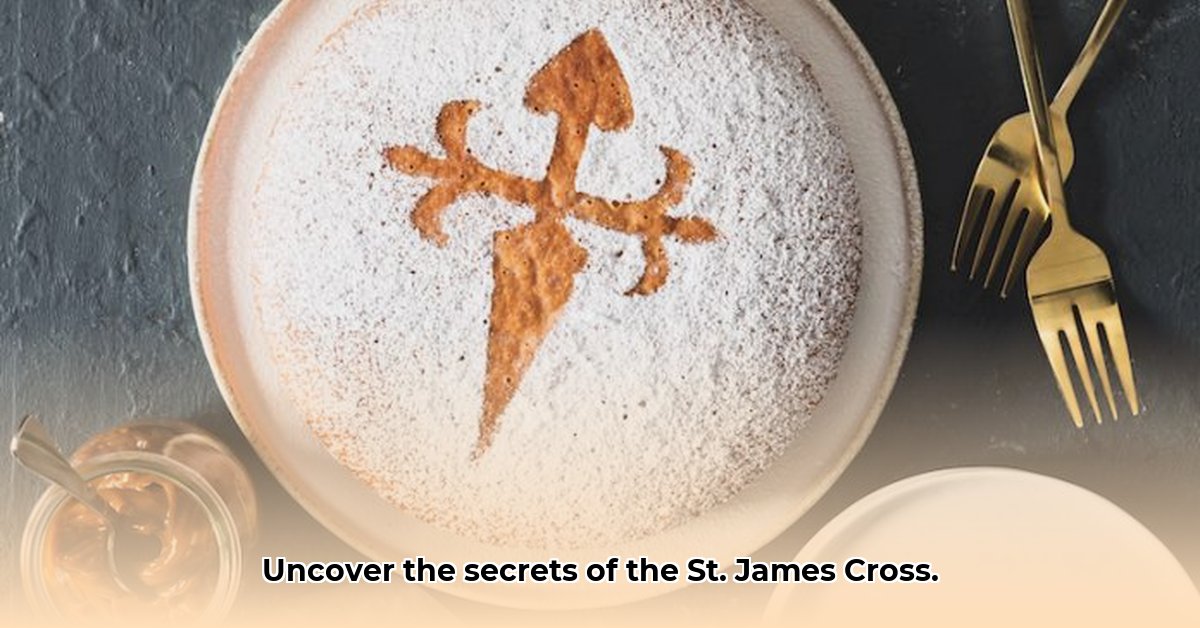The St. James Cross, a distinctive emblem with a sword-like design, holds a significant place in the history and culture of Spain, Portugal, and particularly in Galicia. More than just a religious symbol, it is an icon deeply connected to faith, warfare, pilgrimage, and regional identity, offering a rich and layered narrative that spans centuries. This cruz espada, as it is sometimes known, continues to captivate and inspire, prompting ongoing exploration into its complex origins and enduring influence. For more examples of religious crosses, see these other crosses.
A Symbol Forged in Legend and Devotion: Tracing the Origins
The story of the St. James Cross is inextricably linked to Saint James the Greater, one of the twelve apostles and the patron saint of Spain. Legend holds that his remains were miraculously transported to and discovered in Galicia, in northwestern Spain. This discovery sparked a surge of religious devotion, leading to the development of the Camino de Santiago pilgrimage route, also known as the Way of St. James. The cross became a potent symbol of faith, protection, and spiritual purpose for those undertaking this arduous journey, serving both as a waymarker and a badge of honor signifying completion of the pilgrimage.
Medieval pilgrims often carried scallop shells, the symbol of St. James, and some speculate that the pointed base of the cross mirrored the practice of pilgrims planting small crosses in the ground as acts of devotion. Regardless of its precise beginnings, the cross quickly gained prominence as a visual representation of the apostle and his connection to the Iberian Peninsula. “The Cross of St. James is more than just a symbol; it is a tangible link to our history and the enduring spirit of the Camino,” said [Isabella Rossi, Director of the Camino de Santiago Museum].
The Reconquista and Military Orders: A Battle Cry for Christendom
The St. James Cross became deeply intertwined with the Reconquista, the centuries-long effort by the Christian kingdoms to reclaim the Iberian Peninsula from Muslim rule. In the 12th century, the Order of Santiago, a powerful military and religious order, adopted the cross as its emblem. This order was dedicated to protecting pilgrims on the Camino de Santiago and fighting against the Moors.
Knights of the Order of Santiago wore the cross emblazoned on their white capes and standards, transforming it into a symbol of courage, military prowess, and Christian resistance. This military connection imbued the cross with a new layer of significance, solidifying its presence in churches, flags, coats of arms, and other symbols of authority. The red color, gules in heraldry, is believed to represent the blood shed by Christian soldiers in these battles.
Unpacking the Symbolism: Swords, Lilies, and Blood-Red Meanings
The design of the St. James Cross is rich with symbolism, each element contributing to its multifaceted meaning. The sword-like shape, with its pointed lower end and often fleur-de-lis-shaped arms, is the most distinctive feature.
- The Sword: Represents both the manner of St. James’ martyrdom (he was beheaded with a sword) and the military role of the Order of Santiago in defending Christendom.
- The Fleur-de-Lis: Embody purity, honor, and nobility, reflecting the ideals of chivalry associated with the Order of Santiago. The three petals are also sometimes interpreted as representing the Holy Trinity.
- The Color Red (Gules): Is traditionally believed to symbolize the blood shed by Christian martyrs, particularly St. James himself, and the sacrifices made by those who fought in the Reconquista.
While interpretations may vary among scholars, these symbolic elements collectively contribute to the cross’s powerful and lasting appeal.
The Cross Today: A Living Legacy in Modern Culture
The St. James Cross remains a highly visible and significant symbol today, extending far beyond its religious connotations. It appears on Galician football team jerseys, regional flags, coats of arms of numerous towns and cities, and even on the Tarta de Santiago, a traditional almond cake decorated with the cross in powdered sugar.
Its presence in these diverse contexts represents a strong sense of regional identity, cultural pride, and connection to the past. For many, the cross serves as a tangible link to their heritage, reminding them of the struggles and triumphs of their ancestors. The cross connects people to their history and heritage, serving as a powerful reminder of cultural identity. As it continues to appear in various contexts, this symbol maintains its relevance in contemporary society.
Mysteries and Ongoing Research: Unraveling the Past Through Study
Despite the wealth of existing knowledge, some aspects of the St. James Cross remain shrouded in mystery, prompting ongoing research and debate. The historicity of the Battle of Clavijo, for example, is a subject of scholarly debate, with some historians questioning whether the battle actually took place.
Further research is needed to fully understand the cross’s early origins, its evolution over time, and the nuances of its symbolic meaning. This involves delving into historical archives, studying medieval art and architecture, and exploring lesser-known interpretations of its significance.
A Quick Look at the St. James Cross Timeline
| Period | Key Events | Significance |
|---|---|---|
| Early Middle Ages | Discovery of St. James’s remains in Galicia; Development of the Camino de Santiago | The Camino de Santiago pilgrimage begins; the cross emerges as a symbol of faith, protection, and spiritual journey. |
| Reconquista Era (12th Cent.) | Founding of the Order of Santiago | The cross takes on a military significance, symbolizing the fight for Christianity and the protection of pilgrims. |
| Late Middle Ages – Present | Widespread use in art, architecture, heraldry, regional symbols, and popular culture (e.g., Tarta de Santiago) | The cross becomes deeply ingrained in Galician, Spanish, and Portuguese culture and national identity; its symbolic significance evolves and diversifies, representing regional pride and heritage. |
How to Interpret the Symbolism of the Cross of Saint James: A Guide
The Cross of St. James, or Cruz de Santiago, is a powerful emblem deeply rooted in Spanish, Portuguese, and Galician history and culture. Understanding its multifaceted meaning requires delving into its rich symbolism. The cross serves not only as a religious icon but also as a representation of history, culture, and identity.
- The sword shape is a powerful nod to St. James’ martyrdom and the martial orders who adopted the cross.
- The red color symbolizes the blood of martyrs and military conflict.
- The fleur-de-lis represents purity, honor, and knightly devotion.
The Cross’s Distinctive Design: Interpreting the Visual Narrative
The cross’s unique design tells a story of sacrifice and valor. The sword-like shape connects St. James’s martyrdom with the military orders that embraced the symbol. The vibrant red, associated with the blood of martyrs, reinforces this association. The fleur-de-lis signifies purity, honor, and knightly devotion. Together, these elements create a visual narrative that speaks of sacrifice and valor. Is it possible to understand the significance of the design by not understanding the history behind it?
The Camino de Santiago: A Pilgrimage of Symbols and Meanings
The Cruz de Santiago is inextricably linked to the Camino de Santiago, serving as a waymarker, a symbol of protection, and a reminder of faith and the saint’s protection. The cross symbolizes journey, perseverance, and spiritual discovery. Its presence along the path, from shrines to souvenirs, highlights its significance to pilgrims. What other unspoken symbols are hidden along the Camino, unnoticed by the casual observer?
Unraveling the Mysteries: Origins and Interpretations Explored
One of the enduring mysteries surrounding the cross is its precise origin. Legend connects it to a miraculous intervention by St. James at the Battle of Clavijo in 844 AD. Alternative theories suggest it evolved from early crusader crosses or simple red flags. Regardless of its precise origin, its adoption by the Military Order of Santiago solidified its blend of religious piety and martial spirit. “The Cruz de Santiago is a symbol that encapsulates centuries of history, faith, and cultural identity,” said [Dr. Elena Rodriguez, Professor of History, University of Santiago de Compostela].
The Cross of St. James: Past, Present, and Future of the Icon
The Cruz de Santiago‘s enduring power continues to resonate today in heraldry, flags, and other contexts. Its imagery has permeated society, reminding us how symbols can transcend time and evolve across cultures. The cult of St. James suggests that its influence may be even broader than we currently understand – even the Danish flag has possible links to it. How will future generations reinterpret this potent symbol?
The St James Cross in Galician Cultural Heritage: A Regional Focus and Identity
The Cruz de Santiago is a potent emblem deeply interwoven with Galician and Spanish history. As a symbol forged in history’s crucible, how does it reflect the region’s unique cultural heritage?
A Symbol Forged in History’s Crucible and Military Power
The St James Cross is more than a religious icon, it is a symbol of powerful Christian military prowess. Its distinctive shape, resembling a sword, connects to Crusader practices. The cross became linked to the Reconquista. The cross also became a symbol to St. James’s own martyrdom. What other hidden messages might be embedded within the color and shape?
The Cross and the Camino: A Spiritual Journey of Hope
The Camino de Santiago elevated the cross’s significance as a guiding mark










